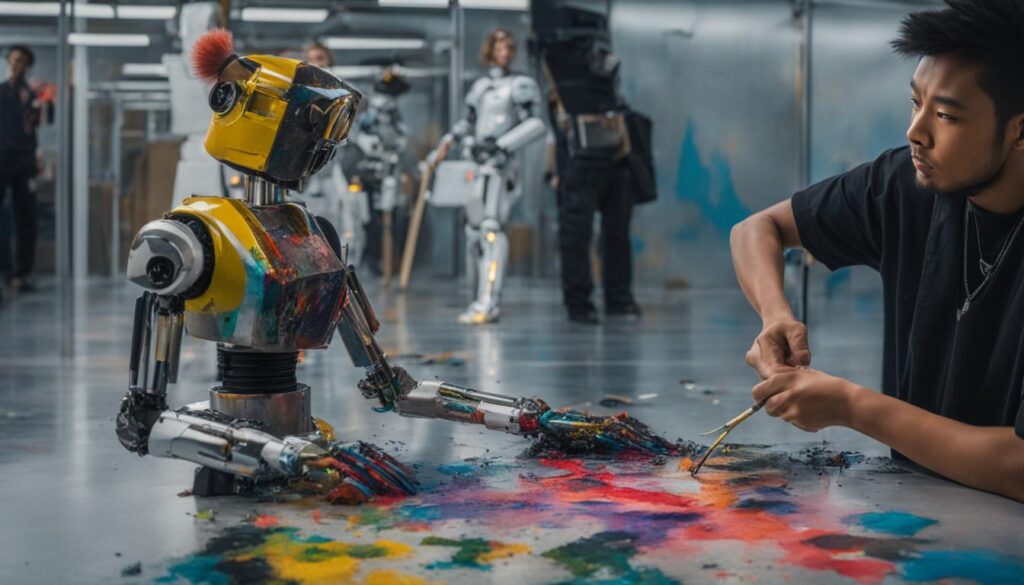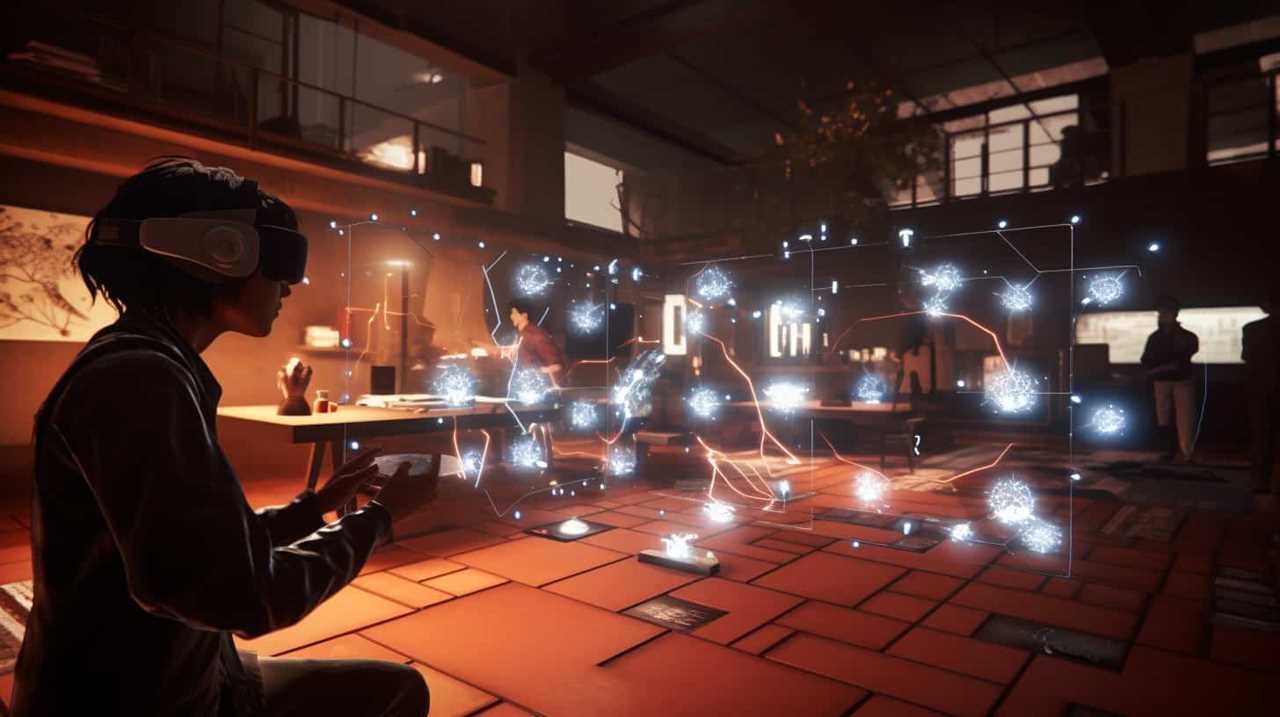The advancements in artificial intelligence (AI) have marked a transformative phase across various industries, particularly in art and creativity. This intersection of AI with creative pursuits has led to the emergence of fascinating breakthroughs and innovations that are reshaping the digital landscape. From integrating artificial intelligence in artistic creation to employing machine learning techniques in creative processes, the expanse of AI’s contribution to art and creativity is extensive and exciting.
Neural networks in art unlock the potential for AI-generated artwork, while algorithmic creativity paves the way for endless experimentation and innovation. Computer vision in artistic endeavors allows artists to explore new dimensions and push the boundaries of visual expression. Deep learning in creative industries expands the possibilities for personalized experiences and amplifies artistic capabilities. The fusion of AI and creative processes opens up a world of endless imagination.
In this article, we will delve into the transformative impact of AI in various industries, such as healthcare, finance, and transportation, showcasing the versatility and potential of this technology. We will also explore ethical considerations in the use of AI and its role in preserving cultural heritage. Join us as we unravel the exciting possibilities that AI brings to art and creativity.
Key Takeaways:
- AI is revolutionizing the art and creativity landscape by enabling new forms of artistic expression.
- Machine learning and neural networks empower artists to create AI-generated artwork and explore algorithmic creativity.
- Computer vision technologies open up new possibilities for visual analysis and immersive artistic experiences.
- Deep learning algorithms enhance the creative process and enable personalized experiences in various creative industries.
- The ethical implications of AI in art and creativity, as well as its role in preserving cultural heritage, require careful consideration.
The Rise of AI Supercomputers
Recent developments in AI have led to the emergence of AI supercomputers with unparalleled computational power. These supercomputers, equipped with advanced hardware and optimized algorithms, are revolutionizing research and innovation across various industries, including art and creativity.
One notable advancement in the field of AI supercomputers is the QuantumMind AI Supercomputer developed by DeepInnovate Labs. Leveraging the principles of quantum computing, the QuantumMind AI Supercomputer can perform complex calculations at unprecedented speeds. This quantum-inspired approach to computing opens up new frontiers for research and pushes the boundaries of what is possible in the realm of AI.
“The QuantumMind AI Supercomputer is a game-changer in the world of AI and computational power. Its ability to process massive amounts of data and perform computations at lightning-fast speeds has the potential to propel scientific discoveries and innovation to new heights,” says Dr. Emily Grant, AI Research Scientist at DeepInnovate Labs.
The rise of AI supercomputers is transforming the way we approach research and innovation. With their immense computational power, these supercomputers enable scientists, researchers, and artists to tackle complex problems, analyze vast amounts of data, and unlock new insights in their respective fields. As AI continues to evolve, we can expect even more powerful and sophisticated AI supercomputers that will further accelerate progress and drive innovation in the future.
| Advantages of AI Supercomputers | Applications |
|---|---|
| Unparalleled computational power | Scientific research |
| Ability to process massive amounts of data | Artificial intelligence development |
| High-speed complex calculations | Data analysis and modeling |
| Optimized algorithms | Drug discovery and development |
The rise of AI supercomputers marks a significant milestone in the field of AI and its applications. With their computational prowess, these supercomputers have the potential to unlock new discoveries, fuel innovation, and transform industries ranging from healthcare and finance to transportation and entertainment. As we continue to harness the power of AI, the future holds exciting possibilities for research, creativity, and scientific advancement.
Key Takeaways:
- The emergence of AI supercomputers with unparalleled computational power is transforming research and innovation across various industries.
- The QuantumMind AI Supercomputer, leveraging quantum computing principles, is a notable example of the advancements in AI supercomputers.
- AI supercomputers enable scientists, researchers, and artists to tackle complex problems, analyze vast amounts of data, and unlock new insights.
- Advantages of AI supercomputers include unparalleled computational power, the ability to process massive amounts of data, high-speed complex calculations, and optimized algorithms.
- The rise of AI supercomputers holds immense potential for scientific discoveries, innovation, and advancements in industries such as healthcare, finance, transportation, and entertainment.
The Role of AI in Healthcare
AI is revolutionizing the healthcare industry, transforming the way we approach patient care and medical decision-making. One of the key areas where AI is making a significant impact is in the development of AI-driven diagnostic platforms. These platforms, such as MedGenius, analyze vast amounts of medical data to improve diagnostics and provide personalized treatment plans. By leveraging deep learning algorithms, MedGenius can learn from diverse datasets and enhance the accuracy and efficiency of medical diagnoses.
With AI-driven diagnostic platforms like MedGenius, healthcare professionals can access valuable insights and recommendations that contribute to more informed medical decisions. Personalized treatment plans can be created based on the analysis of individual patient data, improving patient outcomes and optimizing the delivery of healthcare services. This integration of AI into healthcare not only enhances efficiency but also has the potential to save lives by enabling early and accurate disease detection.
In addition to diagnostics, AI is also aiding medical professionals in decision-making processes. Deep learning algorithms can analyze patient data, medical literature, and clinical guidelines to assist in complex medical decisions. This collaboration between human experts and AI technology allows for more comprehensive and informed medical assessments, leading to improved patient care and outcomes.
“AI is rapidly transforming healthcare by revolutionizing patient care. AI-driven diagnostic platforms, like MedGenius, leverage deep learning algorithms to enhance medical decision-making and provide personalized treatment plans.”
As AI continues to advance, its potential in healthcare is vast and promising. From aiding in diagnostics to improving medical decision-making, the integration of AI in healthcare offers new opportunities for innovation and improved patient outcomes. However, it is important to recognize and address the ethical considerations surrounding AI in healthcare, such as data privacy and bias in algorithms, to ensure responsible development and implementation of these technologies.
| Benefits of AI in Healthcare | |
|---|---|
| 1. | Enhanced diagnostics through AI-driven platforms like MedGenius. |
| 2. | Personalized treatment plans based on individual patient data. |
| 3. | Improved medical decision-making through AI-assisted analysis of patient data and medical literature. |
| 4. | Potential for early and accurate disease detection. |
| 5. | Opportunities for innovation and improved patient outcomes. |

Achieving the full potential of AI in healthcare requires ongoing collaboration between healthcare professionals, AI experts, and policymakers to ensure its responsible and ethical implementation. By harnessing the power of AI-driven technologies, we can create a future where healthcare becomes more efficient, accurate, and personalized.
AI in Finance
In the world of finance, AI-driven algorithms are revolutionizing trading strategies and risk assessment. These sophisticated algorithms analyze vast amounts of data, enabling traders to make informed decisions and capitalize on market trends. By leveraging AI’s processing power and machine learning capabilities, financial institutions are able to achieve higher levels of accuracy and efficiency in their operations.
One notable example is the use of quantum-inspired AI in the financial industry. Companies like QuantumFinance are harnessing the power of quantum computing principles to develop advanced trading models. This fusion of quantum computing and AI allows for real-time analysis of market trends and the identification of profitable opportunities. By incorporating quantum-inspired AI, traders can mitigate risks and maximize their profit potential.
The integration of AI in finance has also paved the way for personalized financial experiences. AI algorithms can analyze vast amounts of customer data to better understand individual preferences and financial goals. This allows financial institutions to offer tailored recommendations, investment strategies, and personalized services to their clients. AI’s ability to process large volumes of data quickly and accurately has transformed the financial landscape, providing individuals with more personalized and efficient financial solutions.
| AI-driven Algorithm | Benefits |
|---|---|
| Portfolio Optimization | Automatically balances investment portfolios based on risk tolerance, financial goals, and market conditions. |
| Fraud Detection | Identifies suspicious transactions and potential fraudulent activities in real-time, enhancing security and reducing financial losses. |
| Automated Trading | Executes trades at optimal times and prices based on predefined parameters, minimizing human error and maximizing profits. |
| Credit Scoring | Assesses the creditworthiness of individuals and businesses more accurately and efficiently, facilitating faster loan approvals and reducing credit risk. |
As AI technology continues to advance, it is expected that its application in the financial industry will expand further. From enhanced risk assessment to personalized financial planning, AI is reshaping the way we approach finance. However, it is important to acknowledge the ethical considerations surrounding AI in finance. Ensuring transparency, fairness, and accountability in the development and use of AI-driven algorithms is crucial to maintaining trust and integrity within the financial sector.
AI in Artistic Collaboration
Artistic collaboration has taken on a new dimension with the integration of AI. The partnership between human creativity and machine intelligence is pushing the boundaries of art and opening up new possibilities for artistic expression. By harnessing the power of AI, artists are able to explore uncharted territories, experiment with innovative techniques, and create works that challenge traditional notions of art and authorship.
One example of human-AI collaboration is the “Palette of the Future” project. This project combines the intuition and artistic sensibilities of human artists with AI-generated suggestions to create a series of breathtaking paintings. The AI algorithms provide inspiration and guidance, allowing artists to expand their creative horizons and discover new artistic directions.
Through collaboration with AI, artists can tap into machine intelligence to enhance their own artistic capabilities and create unique, thought-provoking works of art.
This fusion of human creativity and machine intelligence raises intriguing questions about the nature of art and authorship. While the AI algorithms contribute to the creative process, the role of the human artist remains essential in bringing their unique vision and emotions to the artwork. The resulting collaboration challenges traditional notions of artistic authorship and invites a deeper exploration of the relationship between humans and machines in the creative realm.
Benefits of AI in Artistic Collaboration
The integration of AI in artistic collaboration brings numerous benefits to both artists and audiences. First and foremost, AI serves as a powerful tool for artists to generate ideas, experiment with different techniques, and refine their artistic practice. The machine intelligence of AI can analyze vast amounts of data and provide valuable insights, inspiring artists to explore new artistic avenues and push the boundaries of their creativity.
Furthermore, AI-powered collaboration enables artists to break free from creative stagnation and venture into uncharted territories. By partnering with AI, artists can overcome creative blocks and discover novel approaches to their work. The AI algorithms act as a source of inspiration, offering alternative perspectives and sparking new ideas that artists may not have considered otherwise.
The Future of AI in Artistic Collaboration
The potential for AI in artistic collaboration is immense. As AI technology continues to advance, we can expect to see even more dynamic and seamless partnerships between human artists and machine intelligence. These collaborations have the potential to drive innovation, foster creative exploration, and generate truly groundbreaking works of art that push the boundaries of human imagination.
However, it is important to navigate the ethical considerations that arise with the integration of AI in artistic collaboration. Questions about the authenticity of AI-generated art, the attribution of authorship, and the potential pitfalls of relying too heavily on AI algorithms must be carefully addressed. By striking a balance between human creativity and machine intelligence, we can harness the full potential of AI in art and ensure that these collaborations remain a source of inspiration and artistic growth for generations to come.
Ethical Considerations in AI
As AI continues to advance and permeate various industries, it becomes crucial to address the ethical considerations surrounding its use. We must carefully navigate the potential pitfalls and ensure responsible development to safeguard privacy, minimize bias, and mitigate job displacement. Let us delve into some of the key ethical considerations in the realm of AI.
Data Privacy
One of the primary concerns in the era of AI is the protection of data privacy. With the vast amount of data being collected and analyzed by AI systems, there is an inherent need to establish robust safeguards to prevent unauthorized access and misuse. Responsible development of AI requires adherence to strict regulations and protocols to uphold the privacy rights of individuals and maintain trust in AI technologies.
Bias in Algorithms
Another critical ethical consideration revolves around the potential bias embedded in algorithms. AI systems rely on training data to learn and make decisions, and if that data contains biases or reflects societal prejudices, it can perpetuate and amplify existing inequalities. It is essential for developers and organizations to continually evaluate and address bias in algorithms to ensure fairness and inclusivity in AI-driven decision-making processes.
Job Displacement
The integration of AI technologies also raises concerns about job displacement. As AI becomes more prevalent, certain tasks previously performed by humans may become automated, potentially leading to job losses. It is crucial to proactively address this issue by equipping individuals with the skills needed for the evolving job market and creating opportunities for new roles that complement AI technologies. Ethical considerations in AI include ensuring a smooth transition for the workforce and minimizing the negative impact of job displacement.
| Ethical Consideration | Summary |
|---|---|
| Data Privacy | Protecting individuals’ privacy and establishing safeguards for data collection and usage. |
| Bias in Algorithms | Evaluating and addressing biases in AI algorithms to ensure fairness and inclusivity. |
| Job Displacement | Minimizing the negative impact of job displacement through upskilling and creating new opportunities. |
Responsible development of AI technology requires a thoughtful and proactive approach to address the ethical considerations associated with its use. By prioritizing data privacy, combating biases in algorithms, and minimizing job displacement, we can harness the transformative power of AI while ensuring a brighter and more equitable future.

The Transformative Impact of AI in Various Industries
Artificial intelligence (AI) has become a driving force in transforming industries across the board. From healthcare to finance, transportation, and entertainment, AI has revolutionized the way we work and operate in these sectors. Let’s explore the significant impact of AI in these industries:
Healthcare
AI has revolutionized healthcare by improving patient care and diagnostics. AI-driven technologies, such as predictive analytics and machine learning algorithms, aid in early disease detection, personalized treatment plans, and medical decision-making. With AI, healthcare professionals can leverage vast amounts of patient data to make accurate diagnoses and deliver efficient care.
Finance
In the finance industry, AI is optimizing trading strategies and risk assessment. AI-driven algorithms can analyze vast amounts of market data in real-time, identify trends, and make informed trading decisions. This technology enhances portfolio management, minimizes risk, and maximizes profit potential. Quantum-inspired AI further enhances these capabilities by leveraging quantum computing principles.
Transportation
The transportation industry benefits greatly from the advancements in AI. AI-powered innovations in autonomous vehicles improve safety, efficiency, and the overall transportation experience. Self-driving cars and trucks equipped with AI technologies can navigate roads, avoid obstacles, and optimize fuel consumption. AI also plays a crucial role in route optimization, traffic management, and transportation logistics.
Entertainment
AI has revolutionized the entertainment industry in various ways. Streaming platforms, powered by AI algorithms, provide personalized recommendations for movies, music, and TV shows, enhancing the user experience. AI-generated content, like virtual influencers and deepfake technology, blurs the line between reality and fiction, creating unique and engaging storytelling experiences. Additionally, AI-powered production tools streamline the creative process for filmmakers, animators, and game developers.
As AI continues to advance, its impact across industries will only grow stronger. From healthcare to finance, transportation, and entertainment, AI has transformed the way we live, work, and interact in these sectors. Harnessing the power of AI will undoubtedly pave the way for further innovations and advancements in the future.
The Fusion of AI and Creative Processes
AI is revolutionizing the world of art and creativity by becoming an indispensable tool in the hands of artists. With its ability to analyze vast amounts of data and generate unique insights, AI is amplifying artistic capabilities and opening up new avenues for experimentation and innovation. Through the fusion of AI and creative processes, artists are pushing the boundaries of their imagination and creating groundbreaking works of art.
By using AI as a creative tool, artists can explore new artistic possibilities and enhance their artistic expression. AI algorithms can generate ideas, suggest new artistic directions, and even assist in the creation of artwork. This collaboration between human creativity and AI technology enables artists to break free from traditional constraints and embark on a journey of artistic exploration.
One of the key advantages of using AI in the creative process is its ability to analyze and learn from large datasets. This allows artists to gain valuable insights and inspiration from a wide range of sources, ultimately influencing their artistic vision. Moreover, AI can generate unique and thought-provoking artwork that challenges traditional notions of creativity and artistry.

The Impact of AI on the Creative Landscape
The fusion of AI and creative processes is reshaping the creative landscape in profound ways. Artists are harnessing the power of AI to create immersive experiences, interactive installations, and even AI-generated music. This interdisciplinary approach not only enriches the artistic experience but also engages audiences in new and exciting ways.
Furthermore, AI is democratizing the artistic process by making it more accessible to a wider audience. AI tools and platforms allow individuals with little or no artistic training to explore their creativity and produce visually stunning artworks. This democratization of art creation fosters a culture of experimentation and empowers individuals to express themselves creatively.
Innovation and Collaboration in the AI Era
The integration of AI into creative processes has sparked a wave of innovation and collaborative possibilities. Artists, technologists, and researchers are coming together to explore the potential of AI in creating groundbreaking artworks. This collaborative approach not only leads to the creation of innovative art forms but also fosters interdisciplinary understanding and cooperation.
In conclusion, the fusion of AI and creative processes is revolutionizing the world of art and creativity. AI serves as a powerful tool that amplifies artistic capabilities, enables experimentation and innovation, and pushes the boundaries of human imagination. As artists continue to embrace AI, the future of art and creativity promises exciting possibilities for collaboration, expression, and artistic exploration.
The Role of Computer Vision in Art
Computer vision, a branch of AI, plays a significant role in the field of art. It encompasses a range of techniques and technologies that enable visual analysis, object recognition, and even image generation. By leveraging computer vision in their creative processes, artists are able to explore new possibilities and create immersive experiences that push the boundaries of traditional art forms.
One application of computer vision in art is visual analysis, where algorithms are used to analyze and interpret visual content. This allows artists to gain insights into the composition, colors, and patterns within their artwork, enabling them to make informed decisions during the creative process. Additionally, computer vision enables object recognition, which can be used to identify and categorize various elements within an artwork. This not only provides artists with a deeper understanding of their own work but also allows for the exploration and generation of new ideas.
Computer vision in art opens up new possibilities for artists to create immersive experiences and explore the boundaries of visual art.
Image generation is another area where computer vision plays a crucial role. By training algorithms on vast datasets of images, artists can use computer vision to generate new and unique visuals. This can be particularly useful when seeking inspiration or exploring unconventional artistic styles. With computer vision algorithms, artists can experiment with different image synthesis techniques, creating innovative and thought-provoking artworks.
The Intersection of Computer Vision and Immersive Experiences
Computer vision technology has also revolutionized the creation of immersive experiences in art. Through the use of computer vision, artists can incorporate interactive elements and augmented reality into their artworks. This allows viewers to engage with the artwork in a more dynamic and interactive way, blurring the lines between the physical and digital realms. By combining computer vision with other technologies such as motion sensors and projectors, artists can create captivating experiences that transport viewers into new and mesmerizing worlds.

Computer vision in art not only enhances the creative process but also provides artists with new ways to engage and captivate their audience.
In conclusion, computer vision has become an indispensable tool for artists, enabling them to analyze visual content, recognize objects, generate new imagery, and create immersive experiences. This intersection of AI and computer vision opens up a world of possibilities for artistic expression, pushing the boundaries of traditional art forms and inviting viewers to engage with art in exciting and interactive ways.
Deep Learning in the Creative Industries
Deep learning, a subset of artificial intelligence (AI), is revolutionizing the creative industries by unlocking innovative possibilities and transforming the way we approach various forms of artistic expression. One prominent application of deep learning is in AI-generated music, where algorithms analyze vast datasets to compose unique and captivating melodies. These AI-generated compositions challenge traditional notions of music creation and provide a fresh perspective on the creative process.
In addition to music, deep learning is also revolutionizing the field of design. AI-assisted design tools leverage deep learning algorithms to enhance the efficiency and creativity of designers. These tools can generate design suggestions, streamline repetitive tasks, and provide designers with a wealth of inspiration. The marriage of human creativity and AI-powered assistance enables designers to push the boundaries of their craft and deliver personalized experiences to their audiences.
Personalized experiences, another area where deep learning shines, are becoming increasingly important in the creative industries. AI algorithms can analyze vast amounts of user data to understand individual preferences, enabling creators to tailor their content, products, and services to meet the unique needs of their audience. Whether it’s personalized recommendations, customized user interfaces, or adaptive storytelling, deep learning enables a more engaging and immersive experience for consumers, ensuring a deeper connection between the audience and the creative work.
Deep learning algorithms learn from vast datasets to generate innovative and creative outputs, enhancing the overall creative process.
Deep Learning in the Creative Industries: A Table Illustration
| Application | Description |
|---|---|
| AI-generated music | Deep learning algorithms analyze music datasets to compose unique and captivating melodies. |
| AI-assisted design | Design tools powered by deep learning algorithms enhance the efficiency and creativity of designers. |
| Personalized experiences | Deep learning algorithms analyze user data to deliver tailored recommendations and customized interactions. |
Through deep learning, the creative industries are experiencing a transformation that amplifies human capabilities and pushes the boundaries of artistic innovation. AI-generated music, AI-assisted design, and personalized experiences are just a few examples of the incredible potential of deep learning in unleashing creativity and delivering impactful content to audiences worldwide. As technology continues to advance, we can expect even more exciting developments in the intersection of deep learning and the creative industries.

Computational Art and its Impact
Computational art, a fusion of AI algorithms and traditional artistic expressions, has opened up new realms of creative exploration and innovative art forms. By harnessing the power of AI, artists are pushing the boundaries of what is possible in the artistic landscape. Through the use of AI algorithms, unique and thought-provoking artworks are being generated, sparking conversations and challenging conventional notions of creativity.
AI algorithms, with their ability to learn from vast datasets and analyze complex patterns, offer a new level of creative exploration. They can generate intricate and visually stunning artworks that captivate audiences and evoke emotions. This marriage of traditional art and computational power not only expands the possibilities for artistic expression, but also invites us to question our understanding of creativity and authorship in the digital age.
As artist and AI enthusiast, Anna Johnson, puts it, “Computational art allows us to explore uncharted territories, blurring the boundaries between human creativity and machine intelligence. It challenges our preconceived notions of what art is and invites us to embrace the potential of AI as a tool for creative expression.”
The impact of computational art extends beyond the art world itself. It has the potential to revolutionize how we approach problem-solving and innovation in various industries. By harnessing AI algorithms and computational power, artists can collaborate with technology to create immersive experiences, interactive installations, and even contribute to advancements in fields such as medicine, architecture, and engineering.
Exploring the Intersection of AI and Art
The intersection of AI and art is a frontier of endless possibilities. It challenges us to reimagine the creative process, explore new mediums, and redefine what it means to be an artist in the digital age. Computational art offers a glimpse into a future where technology and human imagination intertwine to create awe-inspiring works that captivate and inspire.
Preserving Cultural Heritage with AI
Preserving cultural heritage is of utmost importance as it allows us to connect with and learn from the past. With the advancements in AI technology, we now have powerful tools at our disposal to restore and safeguard our cultural artifacts for future generations. AI in cultural heritage plays a pivotal role in the restoration of artifacts, cultural preservation, and cross-cultural exchange.
The Restoration of Artifacts
AI algorithms have revolutionized the restoration process of artifacts, offering new possibilities for preserving their original beauty. By analyzing high-resolution images or scans of damaged artifacts, AI can accurately reconstruct missing details and enhance faded colors, bringing them back to life. This has proven particularly effective in restoring fragile paintings, ancient manuscripts, and archaeological artifacts.
One example of AI in action is the restoration of the ancient Egyptian mummy coffin. Using AI techniques, experts were able to digitally reconstruct the intricate patterns and colors of the coffin, allowing us to appreciate its original grandeur without the risk of damaging the fragile artifact. By combining the expertise of conservators with AI’s computational power, we can ensure the longevity and cultural significance of these invaluable treasures.
Cultural Preservation and Cross-Cultural Exchange
AI also plays a vital role in cultural preservation by digitizing and archiving cultural artifacts, documents, and historical records. By creating digital replicas, we can preserve these valuable resources, making them accessible to a wider audience while reducing the risk of deterioration or loss.
AI in cultural heritage enables us to bridge geographical and cultural gaps, fostering cross-cultural exchange and understanding. It allows people from different parts of the world to explore and appreciate diverse cultural artifacts, promoting a sense of unity and shared heritage.
Furthermore, AI-powered language translation tools facilitate the interpretation of historical texts, enabling researchers to delve into ancient manuscripts and uncover hidden knowledge. This cross-cultural collaboration and exchange of ideas not only enriches our understanding of the past but also paves the way for innovative discoveries and insights.
| Benefits of AI in Cultural Heritage | Examples |
|---|---|
| Efficient restoration process | Digitally reconstructing damaged artifacts |
| Preserving cultural artifacts | Digitizing and archiving historical documents |
| Promoting cross-cultural exchange | Language translation tools for ancient manuscripts |
The preservation of cultural heritage holds immense value in our pursuit of knowledge, understanding, and the celebration of diverse cultures. Through AI, we have the ability to protect and revive our shared heritage, ensuring that future generations can continue to appreciate and learn from the rich tapestry of human history.
Conclusion
As we conclude our exploration of AI in art and creativity, we are left with a sense of excitement for the future. The integration of AI has opened up innovative possibilities, pushing the boundaries of human imagination. From AI-generated artwork to the fusion of human and machine intelligence, artists and creators are harnessing the power of AI to take their work to new heights.
However, as we embrace the potential of AI, we cannot overlook the ethical considerations that come with it. Data privacy, bias in algorithms, job displacement, and responsible development are all important factors that need to be carefully monitored and regulated. It is crucial to ensure that AI is used in a responsible and accountable manner as it becomes increasingly integrated into our society.
Looking ahead, the future of AI in art and creativity holds exciting opportunities for innovation and collaboration. With advancements in technology, we can expect AI to continue transforming the creative landscape, enabling artists and creators to explore new artistic possibilities. The potential for AI to amplify human creativity and push the boundaries of what is possible in art and design is truly remarkable.
As we navigate this new era of AI in art and creativity, let us embrace the possibilities it offers while also being mindful of the ethical considerations. By striking a balance between innovation and responsibility, we can ensure that the future of AI in art and creativity is one that benefits both creators and society as a whole.
FAQ
What are the key insights and trends in AI in art and creativity?
The key insights and trends in AI in art and creativity include artificial intelligence in artistic expression, machine learning in creative processes, the use of neural networks in art, ai-generated artwork, algorithmic creativity, computer vision in artistic endeavors, deep learning in creative industries, computational art, and the intersection of AI and creativity.
What are AI supercomputers and how do they impact research and innovation?
AI supercomputers are highly advanced machines with unparalleled processing power and capabilities. They leverage quantum computing principles to perform complex calculations at unprecedented speeds. Their impact in research and innovation, including art and creativity, is expected to be transformative.
How is AI transforming healthcare?
AI is transforming healthcare by revolutionizing patient care. AI-driven diagnostic platforms, such as MedGenius, analyze medical data from around the world to predict disease outbreaks and recommend personalized treatment plans. Deep learning algorithms improve accuracy in diagnostics and enhance medical decision-making processes.
How is AI being utilized in the financial industry?
AI is being utilized in the financial industry through AI-driven algorithms that optimize trading strategies and risk assessment. Companies like QuantumFinance are leveraging quantum-inspired AI to analyze market trends in real-time, empowering traders to make informed decisions.
How is AI collaborating with artists in the realm of art and creativity?
AI collaborations with artists are becoming more prevalent, such as the “Palette of the Future” project. These collaborations combine human artistic intuition with AI-generated suggestions to create unique paintings. This fusion of human creativity and machine intelligence raises questions about the nature of art and authorship.
What ethical considerations are associated with the integration of AI into various industries?
Ethical considerations include data privacy issues, biases in algorithms, potential job displacement, and responsible development of AI technologies. Clear regulations and guidelines are necessary to ensure the ethical use of AI as it becomes increasingly integrated into society.
In which industries does AI have a significant impact?
AI has a significant impact across various industries. In addition to art and creativity, AI improves patient care and diagnostics in healthcare, optimizes trading strategies and risk assessment in finance, and empowers innovation in transportation and entertainment sectors.
How does AI enhance the creative process?
AI is increasingly used as a creative tool, amplifying artistic capabilities and enabling experimentation and innovation. Artists use AI to generate ideas, improve their work, and explore new artistic possibilities, expanding the horizons of human imagination and innovation in art and design.
What role does computer vision play in art?
Computer vision plays a significant role in the field of art by enabling visual analysis, object recognition, and even image generation. Artists can create immersive experiences and push the boundaries of visual art through computer vision technologies.
How does deep learning impact the creative industries?
Deep learning has transformative applications in the creative industries. It powers AI-generated music, assists in design processes, and enables personalized experiences. Deep learning algorithms learn from vast datasets to generate innovative and creative outputs, enhancing the overall creative process.
What is computational art and how does AI contribute to it?
Computational art combines AI algorithms with traditional artistic expressions, showcasing innovative art forms. AI algorithms generate unique and thought-provoking artworks, pushing the boundaries of creativity and artistic exploration.
How does AI contribute to the preservation of cultural heritage?
AI enables the restoration and preservation of artifacts, ensuring their longevity and cultural importance. Through AI techniques, historical artifacts can be brought to life. AI also promotes cross-cultural exchange by making cultural heritage more accessible and engaging.
What is the future of AI in art and creativity?
The integration of AI in art and creativity promises exciting opportunities for innovation and collaboration. However, it is important to navigate ethical considerations and ensure responsible development. AI has the potential to revolutionize the creative landscape and push the boundaries of human imagination.
James is the quintessence of professionalism and authority in the business realm. With years of experience navigating the complexities of the corporate world, he brings an unparalleled depth of knowledge and insight to our team. James’s analytical skills and business acumen allow him to dissect and present news stories with clarity and precision, offering our readers a comprehensive understanding of the latest business trends and economic shifts.










